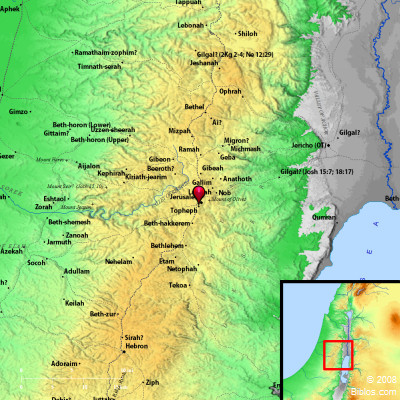Atlas  Washer's Field (Valley of Hinnom) and surrounding region
Maps Created using Biblemapper 3.0Additional data from OpenBible.info
You are free to use up to 50 Biblos coprighted maps (small or large) for your website or presentation. Please credit Biblos.com. Occurrences 2 Kings 18:17 The king of Assyria sent Tartan and Rabsaris and Rabshakeh from Lachish to king Hezekiah with a great army to Jerusalem. They went up and came to Jerusalem. When they were come up, they came and stood by the conduit of the upper pool, which is in the highway of the fuller's field. Isaiah 7:3 Then Yahweh said to Isaiah, "Go out now to meet Ahaz, you, and Shearjashub your son, at the end of the conduit of the upper pool, on the highway of the fuller's field. Isaiah 36:2 The king of Assyria sent Rabshakeh from Lachish to Jerusalem to king Hezekiah with a large army. He stood by the aqueduct from the upper pool in the fuller's field highway. Encyclopedia HINNOM, VALLEY OFhin'-om (ge hinnom, Joshua 15:8; Joshua 18:16; "valley of the son of Hinnom" (ge bhen hinnom), Joshua 15:8; Joshua 18:16 2 Chronicles 28:3; 2 Chronicles 33:6; Jeremiah 7:31; 19:2, 6; 32:35:00; "valley of the children (sons) of Hinnom" (ge bhene hinnom), 2 Kings 23:10; or simply "the valley," literally, the "hollow" or "ravine" (ha-gay'), 2 Chronicles 26:9 Nehemiah 2:13, 15; Nehemiah 3:13 Jeremiah 31:40 and, perhaps also, Jeremiah 2:23 (the above references are in the Hebrew text; there are some variations in the Septuagint)): The meaning of "Hinnom" is unknown; the expressions ben Hinnom and bene Hinnom would suggest that it is a proper name; in Jeremiah 7:32; Jeremiah 19:6 it is altered by the prophet to "valley of slaughter," and therefore some have thought the original name must have had a pleasing meaning.
1. Bible References and History:
It was near the walls of Jerusalem, "by the entry of the gate Harsith" (Jeremiah 19:2); the Valley Gate opened into it (Nehemiah 2:13; Nehemiah 3:13). The boundary between Judah and Benjamin ran along it (Joshua 15:8; Joshua 18:16). It was the scene of idolatrous practices in the days of Ahaz (2 Chronicles 28:3) and of Manasseh, who "made his children to pass through the fire in the valley of the son of Hinnom" (2 Chronicles 33:6), but Josiah in the course of his reforms "defiled Topheth, which is in the valley of the children (margin "son") of Hinnom, that no man might make his son or his daughter to pass through the fire to Molech" (2 Kings 23:10). It was on account of these evil practices that Jeremiah (7:32; 19:6) announced the change of name. Into this valley dead bodies were probably cast to be consumed by the dogs, as is done in the Wady er-Rababi today, and fires were here kept burning to consume the rubbish of the city. Such associations led to the Ge-Hinnom (New Testament "Gehenna") becoming the "type of Hell" (Milton, Paradise Lost, i, 405).
See GEHENNA.
2. Situation:
The Valley of Hinnom has been located by different writers in each of the three great valleys of Jerusalem. In favor of the eastern or Kidron valley we have the facts that Eusebius and Jerome (Onom) place "Gehennom" under the eastern wall of Jerusalem and the Moslem geographical writers, Muqaddasi and Nasir-i-khusran, call the Kidron valley Wady Jahamum. The Jewish writer Kimchi also identifies the Valley of Jehoshaphat (i.e. the Kidron) with Hinnom. These ideas are probably due to the identification of the eastern valley, on account of its propinquity to the Temple, as the scene of the last judgment-the "Valley of Jehoshaphat" of Joel 3:2 -and the consequent transference there of the scene of the punishment of the wicked, Gehenna, after the ancient geographical position of the Valley of Hinnom, had long been lost. In selecting sacred sites, from the 4th Christian century onward, no critica Joshua 15:8; Joshua 18:16) cannot be the "Virgin's fount," the ancient Gihon (2 Samuel 17:17).
See GIHON.
Several distinguished modern writers have sought to identify the Tyropeon Valley (el Wad) with Hinnom, but as the Tyropeon was incorporated within the city walls before the days of Manasseh (see JERUSALEM), it is practically impossible that it could have been the scene of the sacrifice of children-a ritual which must have occurred beyond the city's limits (2 Kings 23:10, etc.).
3. Wady er-Rababi:
The clearest geographical fact is found in Joshua 15:8; Joshua 18:16, where we find that the boundary of Judah and Benjamin passed from En-rogel "by the valley of the son of Hinnom"; if the modern Bir Eyyub is En-rogel, as is certainly most probable, then the Wady er-Rababi, known traditionally as Hinnom, is correctly so called. It is possible that the name extended to the wide open land formed by the junction of the three valleys; indeed, some would place Tophet at this spot, but there is no need to extend the name beyond the actual gorge. The Wady er-Rababi commences in a shallow, open valley due West of the Jaffa Gate, in the center of which lies the Birket Mamilla; near the Jaffa Gate it turns South for about 1/3 of a mile, its course being dammed here to form a large pool, the Birket es Sultan. Below this it gradually curves to the East and rapidly descends between sides of bare rocky scarps, much steeper in ancient times. A little before the valley joins the wide Kidron valley lies the traditional site of AKELDAMA (which see).
E. W. G. Masterman |




